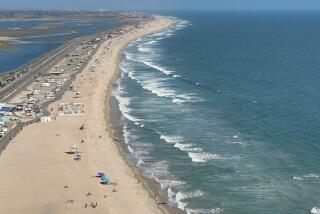Lifesavers, Price-Savers : The Lifeguards in Budget-Conscious Seal Beach Pull Double Duty by BuildingTheir Own Towers
- Share via
SEAL BEACH — The red shorts said “Seal Beach Lifeguards,” but the carpenter’s belt around lifeguard Mark Lees wasn’t for flotation. In its pockets were nails and a hammer Lees used to build a new lifeguard tower Wednesday.
*
With new, prefab towers costing almost $16,000 each, the lifeguards, who have a history of scrounging and cutting corners, are saving the cash-strapped city money by building two new towers for $12,500.
Sign of the low-budget Nineties?
“Yes,” said Lifeguard Chief Dan Dorsey, echoing sentiments at other Orange County coastal cities. With only two full-time lifeguards year-round in Seal Beach, putting on a carpenter’s belt and banging nails is an asset.
“At bigger lifeguard departments you can get into narrow specialization,” Dorsey said. “Not here. You need auto mechanic skills, carpentry, lifesaving, policing skills--the more the better.”
The city’s lifeguard budget has remained at $440,000 for two years, although one full-time position was lost more than a year ago. That funding pays for a junior lifeguard program and a summer staff of about 18 part-time lifeguards during busy summer months when crowds soar to 20,000.
By comparison, Huntington Beach hires 12 permanent lifeguards and staffs 110 lifeguards during the summer. But that city’s lifeguards protect a larger beach area and deal with crowds of more than 65,000 on peak days, said Huntington Beach Lifeguard Capt. Bill Richardson.
Over the years, Richardson said Huntington Beach has bought 20 prefab lifeguard towers costing about $15,500 each. The towers are fiberglass and stainless steel and were constructed at Folsom Prison by inmates working for Prison Industries.
At Seal Beach, winter means smaller beach crowds--though balmy weather on Wednesday attracted about 50 surfers and beach users--and time for building projects.
“We’re going to build two towers this winter,” lifeguard Lt. Steve Cushman said, “and, although the salt air really eats up the wood and metal, they should last 15 to 18 years.”
“We’ve got a guy in the (lifeguard) tower and although we’re pounding nails, if we get the word that there’s a safety situation, we drop our gear and hit it,” said Cushman, who wore jeans over red swimming trunks.
In all, the city owns seven all-wood towers. Cushman said the city’s Public Works Department builds each tower’s heavy base, and then lifeguards use city funds to buy plywood, beams, plate glass, nails and other materials.
“The rest is sweat labor,” he said.
It’s not the first time Seal Beach lifeguards have cut economic corners.
When a fierce storm wiped out a section of the city’s pier in 1982, including its lifeguard tower, Cushman led a lifeguard wrecking crew that salvaged old wood and nails.
They then took a grappling hook to the pier’s aluminum railing, tore it out and installed it atop a new, three-story stucco tower built at the foot of the pier by the lifeguard-carpenters.
Cushman said it helps when part-time lifeguards have other skills such as carpentry. Some have been general contractors.
“I got estimates on the (pier) railing and one contractor wanted $8,000,” Cushman said. “I said, ‘Hell, the whole building only cost us $25,000 to build. So we got the railing off the destroyed section of pier, got corners and it became our new railing on our new tower. It only cost $300 in materials.”
*
Looking around at the city’s lifeguard complex is like a page from Dorsey’s and Cushman’s construction manual.
Their 2,200-square-foot garage was built by them and staff lifeguards in 1985. In earlier years, Cushman used to put in clutches and overhaul the department’s four-wheel-drive Jeeps before they switched to pickups.
To replace a public address system, the financially strapped city department didn’t look in a catalogue and order a new one. Cushman, who lives near Los Alamitos Race Track, visited the track’s maintenance yard to scrounge for any surplus materials he could use.
“They had a 40-foot pole laying around and when I asked, they said, ‘Go ahead and take it if you need it.’ They also had large speakers that had hung on poles their announcer used when they called the horse races and they gave me those, too.”
Cushman had the Public Works Department cut the pole, and installed it on the pier with the speakers. A city electrician helped wire the “new” public address system, and within days, instead of hearing “quarter horse Witch’s Brew by a nose,” lifeguards were ordering bicyclists to walk their bikes on the pier.
More to Read
Sign up for Essential California
The most important California stories and recommendations in your inbox every morning.
You may occasionally receive promotional content from the Los Angeles Times.













